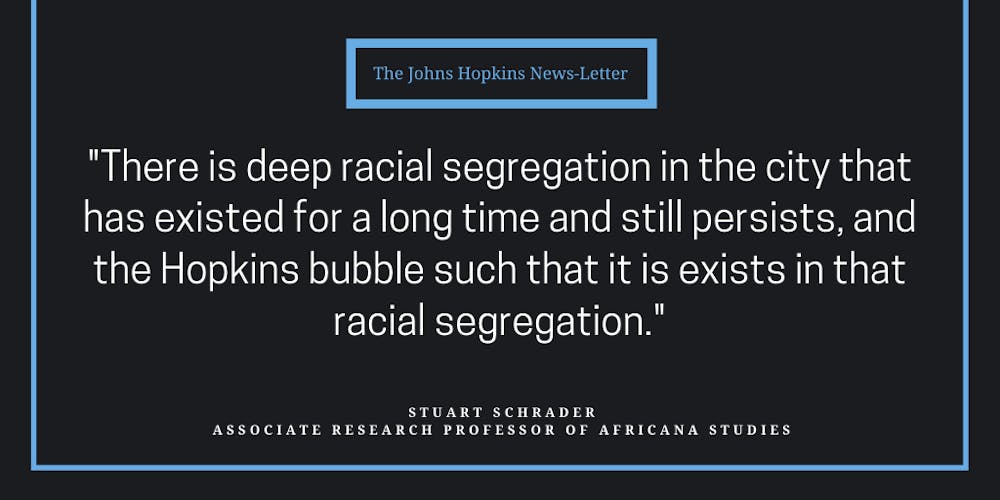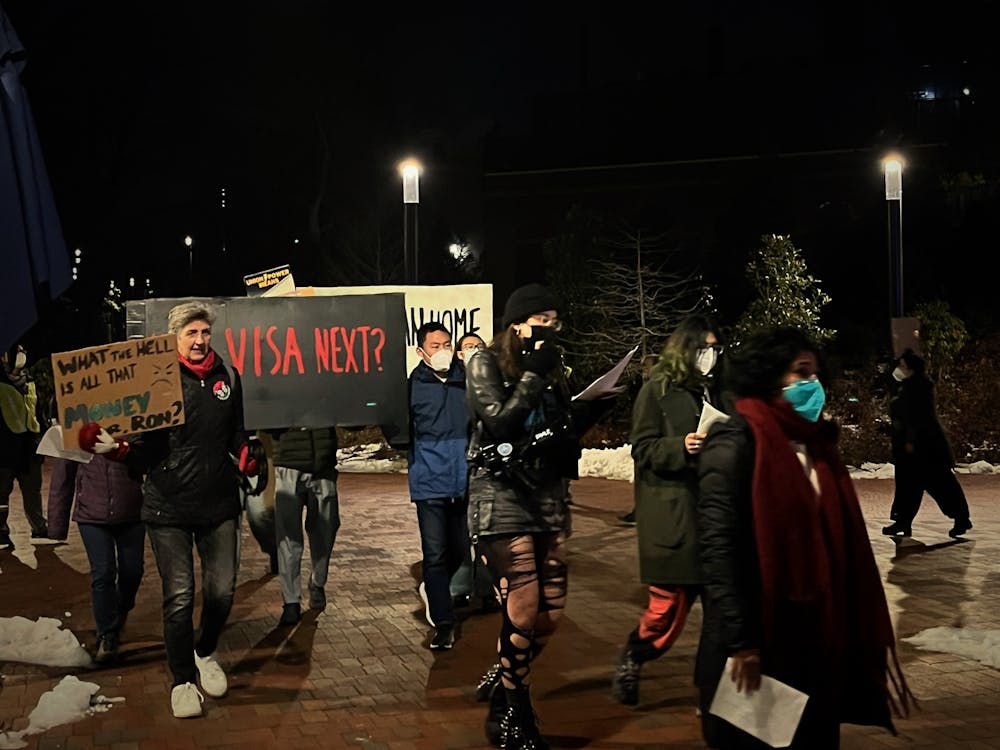The “Hopkins bubble” is the concept that refers to students tending to avoid venturing outside of both the University mindset and the University’s physical boundaries. The bubble has a long history and is the result of various factors.
History
Stuart Schrader, associate research professor of Africana Studies and associate director of the Program in Racism, Immigration and Citizenship, spoke about the history behind the bubble in an interview with The News-Letter.
“The Hopkins bubble isn't just a Hopkins phenomenon. It is actually a part of a broader set of limitations, barriers and restrictions in Baltimore City,” he said. “There is deep racial segregation in the city that has existed for a long time and still persists, and the Hopkins bubble, such that it is, exists in that racial segregation.”
Schrader noted how although Hopkins affiliates are in part responsible for their tendency to not venture far from campus, Baltimore has also been designed to make leaving neighborhoods difficult, particularly to go east and west. He explained how Baltimore is separated into two sections, with Black neighborhoods on its east and west sides and an L-shape dividing them down the middle with white populations, with Hopkins being a part of that division. This phenomenon is often referred to as the Black Butterfly and White L.

Public transportation services are more available in white neighborhoods than in Black ones, making traveling difficult. There are also physical barriers between neighborhoods, including Interstate 83, the light rail tracks and walls.
Schrader also discussed the legacy of suspicion towards Hopkins within the Black Baltimore community.
“There are long-standing reasons for this [mistrust] having to do with past unjust practices by the institution [and] ongoing restrictions and exclusions that the institution places,” he said.
Luc Phinney, an instructor at the Center for Visual Arts, discussed how architecture and landscape contribute to the presence of the bubble.
“I’m so glad [the Mattin Center is] being torn down because it was a barrier. The impression of the brick wall was just opaque, literally and experientially — ‘Don’t go here, this isn't yours, this is someone else’s territory,’” he said.
Phinney reflected on how urban planning in Baltimore resulted in a lack of connectivity among neighborhoods.
“Baltimore is such a patchwork of failed grand plans and small communities falling under the radar,” he said. “I think when you get to the periphery of campus, you start to see the local logic of Baltimore... The student needs to go out there to see that stuff.”
Community perspectives
Julian Lasher, a sophomore at Hopkins, spoke on why he thinks many of his peers don’t venture outside of the bubble.
“I think that fear, maybe, and ignorance about the nature of Baltimore prevents people from going outside. I think people are quite comfortable in the wealthy, sheltered bubble we have here on campus,” he said. “Maybe they’re a little unsettled when they go into the surrounding neighborhoods of Baltimore where there is a lot of deprivation and people are contending with more real problems.”
Yvette Bailey-Emberson, a senior and lifelong Baltimorean, echoed Lasher’s sentiments and noted that the security walk during orientation (it has since been modified to a community asset walk) set a bad first impression of the city for students.
“I think they need to be part of a larger talk about Baltimore and about the good that Baltimore has, not just this fear-mongering,” she said.
43% of University employees at its Baltimore campuses are from Baltimore City. Sarah Robinson has worked for Hopkins for 43 years, currently as a cashier at Charles Street Market (CharMar). Robinson discussed whether she ever felt a barrier between her and the University.
“I have never felt a barrier. That’s why I’ve been here for so long. Especially coming up when I had two kids, it worked out,” she said. “I live close by... I love the students, and I cater to them as if they were my own.”
Policing
One of the University's propositions to make students feel safer is the establishment of the University’s proposed police force, the Johns Hopkins Police Department (JHPD). The rollout of JHPD was put on a two-year pause in June 2020 in response to the Black Lives Matter protests following the murder of George Floyd by Minneapolis police.
Schrader, who specializes in race, policing and counterinsurgency, discussed how safety policy discussions contribute to the bubble.
“I think that it is incumbent on people at this institution to not let our policy recommendations be driven by fear and paranoia and to be based on research and evidence,” he said. “To summarize into a sentence, public safety will never come through more policing.”
Fostering connections
Departments like the Center for Social Concern (CSC) offer opportunities for student involvement in the greater Baltimore area. These opportunities include the Community Impact Internships Program (CIIP), the France-Merrick Civic Fellowship and Community-Based Learning courses.
Bailey-Emberson, who works as a program assistant for CIIP, shared that the experience helped equip her to counter the narratives around safety and get to know the city better.
“I come back and take my roommates to these places and tell my friends about places we go... CIIP helped me to be that guide to these different places because I didn't even know them growing up in the city... and [to develop] a deeper connection to why it's important for me to go to these places to break the boundary that there already is with Hopkins,” she said.
Misti McKeehen, executive director of the CSC, emphasized that the center’s work aims to connect students with their passions and the city.
“Being able to connect with us, we would be happy to help guide you and think through what would be the right fit for you. Also Google — see what you're interested in, what you're passionate about and find some events, especially outside of Charles Village,” she said.
McKeehen spoke of how efforts to break the bubble require genuine engagement with the entire community, including Baltimore residents.
“How do we listen to communities, how do we support them and how do we push the student population and ourselves, in many cases, to make that decision — and push ourselves out of what can be based on a comfort-zone issue, that is labeled as a bubble issue?” she said.
Bailey-Emberson touched on how those involved with Baltimore community engagement tend to be from the same circle of students.
“I do definitely think that Hopkins students as a whole aren't really pursuing these things. I think people want to get involved with Baltimore; it's really hard to fit it in with how intense Hopkins [is],” she said.
Various initiatives have been floated by the University to encourage student engagement with Baltimore. These include seminars focused on issues in Baltimore and service initiatives, including the President’s Day of Service.
Bailey-Emberson suggested the expansion of these programs and courses to a wider scope of students on an institutional level.
“Just making people take courses, like the Introduction to Social Policy course, which focuses a lot on Baltimore... It really shows that a lot of the issues that cities like Baltimore have is because of racist policies that we haven’t been able to shake off,” she said.





